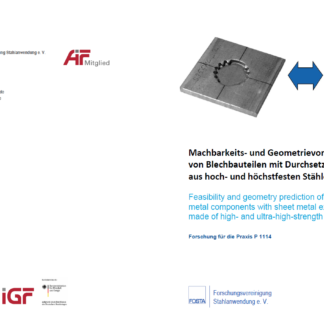Description
P 1114 – Feasibility and geometry prediction of sheet metal components with sheet metal extrusions made of high- and ultra-high-strength steels
The reduction of manufacturing costs is a primary aim for increasing the competitiveness of producing companies. In this context, embossing, also referred to as offsetting or sheet metal extrusion, shows great potential as it offers the possibility to create functional surfaces within a single manufacturing step and without any post-processing.
In DIN 8587, embossing is defined as a shear-forming process, in which one part of a work-piece is displaced relative to another with a linear tool motion. The plastic deformation is mainly caused by a state of shear stress, equivalent to fine blanking or blanking with a small die clearance. Similarly, the technology and tool kinematics are alike in these processes. This leads to the conclusion that embossing resembles a shear cutting process, though without completely cutting through the work-piece.
To reduce the weight of components as well as to waive a refinement process, high- and ultra-high-strength steels are being used increasingly. In engineering and design, there is almost no empirical data for these materials. In order to ensure process reliability in the early development phase, the process is simulated with the finite element method.
Here, material modelling is the greatest challenge. During the shearing process, the temperature in the shearing zone can rise to 300 °C. Furthermore, high strains and strain rates, which cannot be reproduced by conventional experiments like the tensile test, are to be expected.
To reduce the experimental effort, a methodology is presented and validated in this research project to allow a geometry and feasibility prognosis of sheet metal parts with embossings in spite of this challenges. This is accomplished by dividing the embossing line in recurrent geometrical elements. The characteristic shape of these embossings is identified experimentally. In the following, a material model is determined by simple tests and used as the initial point for the simulation. The difference between simulation and experiment is compensated by an adaptation of the material model.
By interpolating between these geometrical elements, it is possible to adapt the material model locally for complex embossing geometries. This enables to evaluate the feasibility and geometry of embossings out of high- and ultra-high-strength steels during the early development phase.
Main content only available in german language.
Published in:
March 2020
Authors:
Prof. Dr.-Ing. W. Volk, J.-M. Stahl M.Sc.




